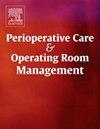按摩治疗减轻心脏手术后疼痛和焦虑的疗效:一项系统回顾和荟萃分析
IF 1
Q2 Nursing
Perioperative Care and Operating Room Management
Pub Date : 2025-01-10
DOI:10.1016/j.pcorm.2025.100465
引用次数: 0
摘要
尽管有对照试验(ct)和少量荟萃分析调查了按摩对术后疼痛和焦虑的影响,但最近在这一领域的综合综述很少。目的本研究旨在通过量化按摩治疗对心脏手术患者疼痛和焦虑水平的影响来填补这一空白,从而丰富现有文献。设计系统回顾和荟萃分析。结果间异质性较大,采用随机效应模型估计效果。数据来源检索2023年7月至10月的ct,检索5个数据库(Scopus、Clinical Key、Web of Science、Pubmed、Science- direct)。结果纳入19项对照试验,结果显示按摩治疗可有效减轻术后疼痛(95% CI, g = 0.899, p <;.000)和焦虑(95% CI, g = 0.705, p <;组织)。在我们的研究中,根据按摩者和按摩类型的不同,效果大小有显著差异(p <;0.05),表明这些因素显著调节了按摩治疗减轻疼痛和焦虑的效果。结论将推拿疗法纳入心脏手术患者的术后康复计划,可有效缓解患者的疼痛和焦虑。因此,按摩疗法代表了传统护理方法的一种有价值的补充方法。本文章由计算机程序翻译,如有差异,请以英文原文为准。
Efficacy of massage therapy in alleviating pain and anxiety post-cardiac surgery: A systematic review and meta-analysis
Background
Despite the existence of controlled trials (CTs) and a handful of meta-analyses investigating the effects of massage on postoperative pain and anxiety, recent comprehensive reviews in this area are scarce.
Aim
This study seeks to fill this gap by quantifying the impact of massage therapy on pain and anxiety levels in patients who have undergone cardiac surgery, thereby enriching the existing body of literature.
Design
A systematic review and meta-analysis.
Review methods
The random effect model was applied to estimate the effects since the heterogeneity between results was high.
Data Sources
Five databases (Scopus, Clinical Key, Web of Science, Pubmed, Science-Direct) were searched for CTs from July to October 2023.
Results
The analysis included 19 control trials and showed that massage therapy is effective in reducing postoperative pain (95 % CI, g = 0.899, p < .000) and anxiety (95 % CI, g = 0.705, p < .000). In our study significant variations in effect sizes based on the person applying the massage, and the type of massage used (p < .05 for all), suggesting these factors significantly moderate the effect of massage therapy on pain and anxiety reduction.
Conclusion
The results advocate for the integration of massage therapy into the postoperative recovery plans of patients undergoing cardiac surgery, highlighting its potential to alleviate pain and anxiety effectively. As such, massage therapy represents a valuable complementary approach to traditional care methods.
求助全文
通过发布文献求助,成功后即可免费获取论文全文。
去求助
来源期刊

Perioperative Care and Operating Room Management
Nursing-Medical and Surgical Nursing
CiteScore
1.30
自引率
0.00%
发文量
52
审稿时长
56 days
期刊介绍:
The objective of this new online journal is to serve as a multidisciplinary, peer-reviewed source of information related to the administrative, economic, operational, safety, and quality aspects of the ambulatory and in-patient operating room and interventional procedural processes. The journal will provide high-quality information and research findings on operational and system-based approaches to ensure safe, coordinated, and high-value periprocedural care. With the current focus on value in health care it is essential that there is a venue for researchers to publish articles on quality improvement process initiatives, process flow modeling, information management, efficient design, cost improvement, use of novel technologies, and management.
 求助内容:
求助内容: 应助结果提醒方式:
应助结果提醒方式:


